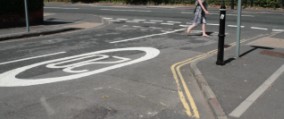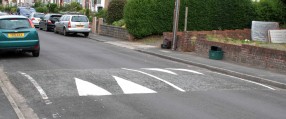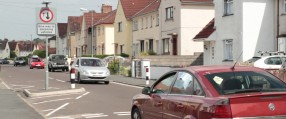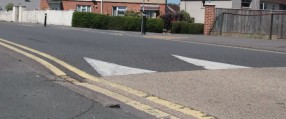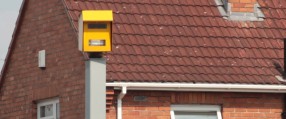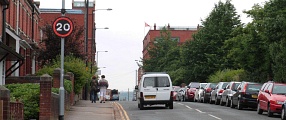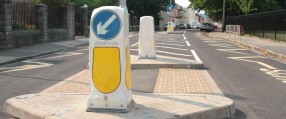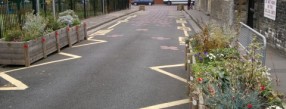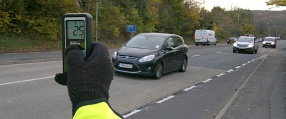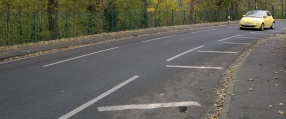Speed Cushions

A speed cushion is a short, raised, rounded device, normally in the centre of a road lane. Speed cushions are designed to be slightly wider than a car, so car drivers need to slow down and drive over the centre of the speed cushion to reduce discomfort. Buses are wider than cars, so they can drive over speed cushions without passengers feeling anything. In Bristol, speed cushions are normally 1.6m wide.
Disadvantages
- Cars drive considerably faster over speed cushions than speed humps or speed tables
- Bus companies and emergency services may oppose wider speed cushions (e.g. 1.7m wide) which are proven to be more effective at slowing down cars
- Some traffic is likely to transfer onto alternative routes, potentially causing a problem somewhere else
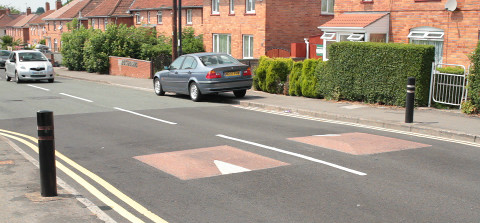
Considerations
- May cause traffic to divert to other routes
- Speed cushions could create noise and vibration which is heard and felt in residences nearby. A greater distance between speed cushions and residences will reduce this problem.
Design
Speed cushions can be made in three different ways, with each being used in Bristol. They can be made from rubber pieces, which are attached to the road; made from raised layers of shaped tarmac; or made from pre-cast concrete sections, which are dropped into the road. In the picture above, pre-cast concrete cushions are shown - they're now the most favoured design in Bristol because they require the least maintenance.
Advantages
- Buses don't need to slow down
- More effective than horizontal treatments at reducing speed
- Emergency vehicles can travel drive more quickly over cushions than speed humps or tables
- Can be avoided by cyclists
- Drainage should not be affected
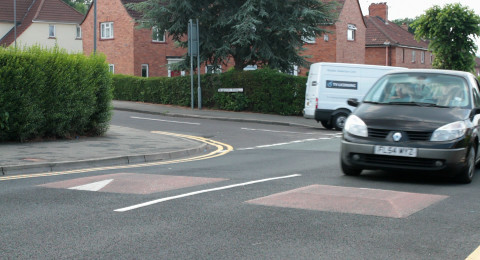
Effectiveness
Generally, vertical treatments - such as speed humps - are expected to reduce accidents by around 44%.
Motor vehicles are likely to travel at around 17mph over a speed cushion. If there's a series of speed cushions, motor vehicles are likely to travel at 22 mph between them.
Speed cushions are effective at reducing motor vehicle speeds, however they are not as effective as speed tables or speed humps.
Reducing motor vehicle speeds increases safety because:
- The vehicle has travelled less distance before the driver can react to a hazard
- Breaking distance is reduced, so the vehicle can stop more quickly before a hazard
- A slower moving vehicle will exert less energy on occupants as the vehicle rapidly changes speed on impact (crashes)
- A slower moving vehicle will transfer less energy to a pedestrian in the event of a collision.
Restrictions
- Speed cushions are normally used in residential areas, or local distributor roads.
There's also some general restrictions to note for all schemes
Advanced information
Likely motor vehicle speeds when travelling over speed cushions is taken from TRL report 312 (Layfield & Parry, 1998). The report is based on Local Authority data at 34 speed cushions schemes from around England. All sites had 30 mph speed limits except four, which were in 20 mph zones. Vehicle speeds between cushions is based on average separation of 71 meters (ranging from 50m to 105m) between the devices, with an 85th percentile speed of 26mph. Overall, the quality of this study is very poor - there is no methodological detail given, including any use of control sites, or before/after data collection periods. In the absence of other, specific analysis on speed cushions, this paper is used as a guide for effects on speed.
44% reduction in accidents is taken from Mountain, Hirst and Maher (2005). The study calculated accident reductions from various different types of traffic calming measures. Local authority and police data were used throughout Great Britain from 150 speed management schemes on 20 mph roads. Analysis is particularly strong, with correction for change in flow, accident trend and regression to mean.
Factors associating reduced motor vehicle speed to road safety are based around Wilson et al (2010), who note the large body of research consistently linking casualty rate with speed (e.g. TRL 421).
References
Layfield, R. & Parry, D. (1998) Traffic calming - speed cushion schemes (TRL312). Transport Research Laboratory. Crowthorne, UK.
Mountain, L., Hirst, W., Maher, M. (2005) Are speed enforcement cameras more effective than other speed management measures? The impact of speed management schemes on 30 mph roads. Accident analysis and prevention 37 pp. 742 - 754.
Taylor, M., Lyman, D., Baruya, A. (2000) The effects of drivers' speed on the frequency of road accidents (TRL421). Transport Research Laboratory. Crowthorne, UK.
Wilson, C., Willis, C., Hendrikz, JK., Le Brocque, R., Bellamy, N. (2010) Speed cameras for the prevention of road traffic injuries and deaths (Review). The Cochrane Collaboration. John Wiley & Sons.
